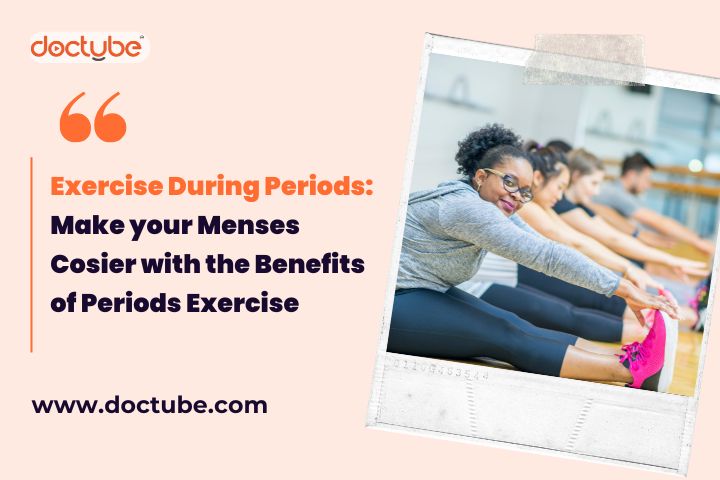Exercise during periods: Make your menses cosier with the benefits of periods exercise
Are you also one of those who say no to exercise during periods?
For every feminine soul, menstruation is that time of the month when cramps dominate all other pains and laziness overpowers. Lying down on the bed with a hot bag is cosier than sweating out on a treadmill. But what if exercising during that part of the month will bring you unexpected benefits? Yes, exercise during periods is gaining popularity because of the diverse benefits it provides. However, it doesn’t mean that you will be asked to run a mile.
Benefits of doing exercise during periods
Exercising has always been correlated with both physical and mental benefits. So, why stop reaping these benefits even during periods, isn’t it! Experts reveal that exercising during that time of the month could help to ease many of the common complaints faced by most women. Some of the noteworthy benefits that you would be able to glean from exercising are as follows:
- It will improve your mood: The sudden change in mood, from going high to low is all that most girls experience before and during menstruation. In this, periods exercise greatly help to improve moods by boosting endorphins. It can also counteract feelings of lethargy and fatigue often experienced during periods.
- It will ease your period cramps: Are you also one of those who rely on painkillers on those hard days of the month? Sop doing this right today! Painkillers have an adverse impact on the kidneys. So, opt for an alternative and nothing could be better than exercising! The release of endorphins during exercise acts as a pain reliever. Further, physical activity stimulates blood flow and relaxes the muscles, providing relief from discomfort.
- It will increase your energy levels: Contrary to popular belief, physical activity during periods can actually increase energy levels. Exercise improves circulation, delivers more oxygen to the body, and boosts metabolism, resulting in enhanced energy and reduced feelings of fatigue.
- It will relieve your stress: Exercise is an effective stress reliever, and this holds true during periods as well. Engaging in physical activity helps release tension and promotes relaxation, potentially reducing stress levels and promoting mental well-being.
- It will reduce your bloating and water retention: Some women experience bloating and water retention during their menstrual cycle. Exercise during periods can help alleviate these symptoms by promoting sweating and reducing excess fluid buildup in the body.
- It will let you sleep better: Regular exercise during periods can contribute to improved sleep quality. Physical activity helps regulate hormones, reduce anxiety, and promote relaxation, leading to better sleep patterns.
It's important to note that every woman's experience during periods is unique, and the level and type of exercise that feels comfortable and beneficial may vary. It's always recommended to listen to your body, adjust the intensity and duration of exercise as needed, and consult with a healthcare professional if you have any concerns or specific medical conditions.
Consider these exercises on period days
Every body is different, every body is unique. So, when choosing exercises to do during your period, it's important to listen to your body. Select those activities that will let you feel comfortable and provide relief. Here are some exercises that are generally well-suited for period days:
Walking or jogging: Taking a brisk walk or light jog can help increase blood flow, relieve cramps, and improve mood without putting excessive strain on your body.
Yoga or stretching: Gentle yoga poses or stretching exercises can help alleviate muscle tension, reduce pain, and promote relaxation. Focus on poses that target the lower back, hips, and abdomen to specifically address menstrual discomfort. A recent study revealed that yoga is a safe and cost-effective way that aids in relieving premenstrual symptoms (Chang, H.C., Cheng, Y.C., Yang, C.H., Tzeng, Y.L. and Chen, C.H., 2023, April. Effects of Yoga for Coping with Premenstrual Symptoms in Taiwan—A Cluster Randomized Study. In Healthcare (Vol. 11, No. 8, p. 1193). MDPI.). Some of the yoga poses that are worth making part of your periods exercise list are
- Supta Baddha Konasanana (Supported Cobblers Pose)
- Setu Bandha Sarvangasana (Supported Bridge Pose)
- Paschimottanasana (Western Stretch/Forward Fold)
- Viparita Karanai (Legs-Up-The-Wall)
Pilates: Pilates exercises can strengthen the core, improve posture, and enhance overall body flexibility. Choose modified versions of exercises that avoid excessive pressure on the abdominal area. You can choose:
- Mermaid
- Bridging
- Cat stretch
This will help to promote blood flow to the stomach and pelvis by contracting these muscles, and then using them in a lengthening position in extension. This will help to relax the abdomen and relieve bloating and tension. So, make your mat your best friend.
Swimming or water aerobics: Water-based exercises can be soothing and provide relief from cramps and PMS (Samadi, Z., Taghian, F. and Valiani, M., 2013. The effects of 8 weeks of regular aerobic exercise on the symptoms of premenstrual syndrome in non-athlete girls. Iranian journal of nursing and midwifery research, 18(1), p.14.). Swimming or engaging in water aerobics can also help reduce bloating and promote a sense of weightlessness. However, while swimming during periods make sure either to use a tampon or a menstrual cup and never go with a pad. This will prevent leakage.
Cycling or stationary biking: Cycling or using a stationary bike can be an effective low-impact cardiovascular exercise that helps increase blood flow and reduce cramps. Adjust the intensity according to your comfort level.
Without failure consider these tips while doing exercise during period
Remember, every woman's experience is unique, so it's essential to pay attention to your body and adjust your workout routine accordingly. Here we bring you some basic tips to consider for a comfortable and effective workout:
- Choose comfortable clothing: Opt for loose-fitting, breathable, and moisture-wicking clothing to help regulate body temperature. This will help to minimise any potential discomfort.
- Use menstrual products: Depending on your flow, use appropriate menstrual products such as tampons, pads, or menstrual cups to ensure comfort and prevent any leakage while exercising. Consider wearing dark-coloured bottoms or using backup protection for added peace of mind.
- Warm up properly: Before starting your workout, take a few minutes to warm up your body. This can include gentle stretching or even a short walk. Warming up prepares your muscles for activity and helps reduce the risk of injury.
- Modify intensity and duration: Adjust the intensity and duration of your workout based on how you feel. It's perfectly fine to opt for a lighter workout or reduce the duration if you're experiencing more discomfort than usual. Listen to your body and don't push yourself too hard!
- Stay hydrated: Drink plenty of water before, during, and after your workout to stay hydrated. Proper hydration can help reduce bloating, cramps, and fatigue.
- Take breaks and rest as needed: If you feel the need to rest or take breaks during your workout, listen to your body. Don't hesitate to pause or modify exercises to accommodate any discomfort you may be experiencing.
- Post-workout care: After exercising, take a few minutes to cool down and stretch your muscles. This can help reduce muscle soreness and promote faster recovery.
If you have any concerns or specific medical conditions, it's always advisable to consult with a healthcare professional before fixing your exercise regime. This will help to make exercise on period more soothing and comfortable.








Post a Comment